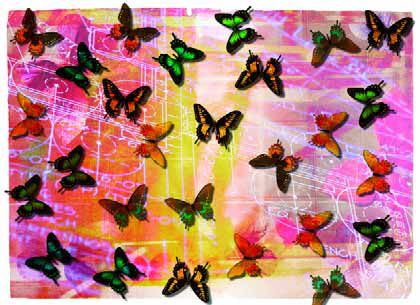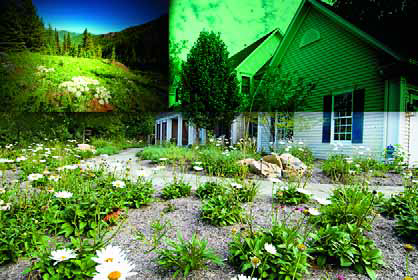waterfall
In December 2004, WaterShapes introduced ‘The Platinum Standard,’ a registry of projects that embodies watershaping…
In the often wild and woolly world of custom landscape and watershape design, it’s sometimes impossible to predict the sources of the most interesting and challenging projects – or anticipate how we manage to find our ways into the middle of them. It’s all part of what makes this profession so uplifting at times – and so confounding at others. I’ve worked hard to accept and embrace the strange tides of fortune this business entails. As a case in point, this month (and next) I’m going to relate a story that captures the essence of what it can take to accommodate the unexpected and enlist the nerve it sometimes takes to
My part of New York hasn’t been hit too hard so far, but it seems these days as though much of the United States is in the throes of a sustained and (in places) severe drought. Even where I am, we’re in what the meteorologists are calling a “moderate” dry spell. This turn of events has made me determined to design landscapes requiring as little water as possible – one consequence being that I now do all I can to avoid using large expanses of
To the casual observer, it might seem that what we do is all about artificial rock. But if you look closer, I think a better description is that we work in the business of "themed construction." While much of our work centers on the creative use of artificial rock, we do much more than shape that raw material in fashioning the archaeological replicas, exotic watershapes, zoological exhibits and grand-scale sculptures of which the rockwork is a part. As we see it, what we do is develop whatever sort of tableau a client might want in whatever media might help us capture it. As a consequence, our work at The Lakeland Co. (Rathdrum, Idaho) has brought us into contact with an incredibly broad spectrum of projects in a wide range of settings, from
To the casual observer, it might seem that what we do is all about artificial rock. But if you look closer, I think a better description is that we work in the business of "themed construction." While much of our work centers on the creative use of artificial rock, we do much more than shape that raw material in fashioning the archaeological replicas, exotic watershapes, zoological exhibits and grand-scale sculptures of which the rockwork is a part. As we see it, what we do is develop whatever sort of tableau a client might want in whatever media might help us capture it. As a consequence, our work at The Lakeland Co. (Rathdrum, Idaho) has brought us into contact with an incredibly broad spectrum of projects in a wide range of settings, from
Creating watershapes and landscapes that are natural in appearance is always a challenge, says Ken Alperstein of Pinnacle Design, a firm that specializes in high-end projects related to top-flight golf courses. For this project in Shady Canyon, however, the ante was upped considerably by the site's location in an environmentally sensitive coastal canyon in southern California - a design challenge intensified by regulatory scrutiny every step of the way. It was a job that forced everyone involved to be on exactly the same page at all times. The landscapes and watershapes at the Shady Canyon Golf Club in Irvine, Calif., were developed by the Irvine Company as the heart of an upscale residential community. The wilderness area set aside for the course and its immediate surroundings had a subtle, bucolic charm all its own - a character the design team needed to
Whether we function as designers or builders or both, we watershapers tend to be flexible folk: We mold ourselves to projects and situations and tasks when we're called on to apply our skills and experience, and this often leads us to perform in unanticipated ways. This sort of adaptability is a way of life for most of us: It's a talent we use to produce success. But even the most adaptable practitioners of the watershaping arts will, every once in a while, encounter a project that shocks the system, alters all formulas and breaks down familiar parameters. In these rare cases, just surviving the process is an accomplishment that brings a sense of relief as well as a sense of amazement that both you and the project made it through to completion. I was recently fortunate enough to be part of just such a project - a fascinating set of challenges now known as the Smithsonian Institution's National Museum of the American Indian in Washington, D.C. It's the last museum that will be
As milestones go, the project depicted in these pages has been a big one for me - and for lots of other people as well. The grand estate with its outsized home is located in the countryside near Hanover, Pa., a remote setting that offered a set of challenges that has in many ways redefined what is and isn't possible in a whole region when it comes to watershape design, engineering and construction. A full two-and-a-half years in the making (a period broken up, of course, by stretches in which there was no activity on site), this stands as one of
Think of it: Just below the surface of our ponds and streams is a wonderful potential for beauty, an amazing opportunity to open observers' eyes to an entire submerged "landscape" made possible by virtue of completely clear water. I like to picture it as an "underwater garden," which is why, to me, water clarity is an essential component of my ponds and streams. Too often, however, I run into settings in which it simply has not been a priority for the designer or installer. I'm further distressed when the subsurface views I treat as key design elements are left partially or wholly unconsidered. I think back to my family's trips to the seashore, where we would spend hours observing rocky tidal pools. Peering into the water and seeing a world of oceanic plants and animals at close proximity was a profound source of fascination and excitement. It is for me still – and, I believe, for most other people as well. What I see in tide pools is a perfectly balanced, utterly natural underwater garden filled with beautiful stone colors, textures weathered by the action of the waves and tides and a plethora of pebbles and sand mixed with bits of seashell. It is here that we may
During a lifetime of driving up and down the part of Sunset Boulevard where it finally meets the Pacific Ocean, I'd often noticed the sign pointing to "Lake Shrine" but had never taken the time to stop and have a look. I suppose the "shrine" part of it made me think it was the exclusive preserve of adherents or members of the Self-Realization Fellowship - an organization I knew nothing about other than that their facility was in one of Los Angeles' most beautiful locations. I finally overcame my hesitation about visiting the Lake Shrine a couple years ago, when a friend told me it was a place where people of all faiths and religions were welcome to stroll, meditate and enjoy the tranquility of the setting. Curiosity overcame skepticism and I finally visited the place. What I found at the Lake Shrine was a serene, calm, meditative oasis of lush, beautiful gardens surrounding a lake. To this day many years later, the minute I drive through the entrance gate, I'm always swept up by sensations of serenity and peace - and have since





















